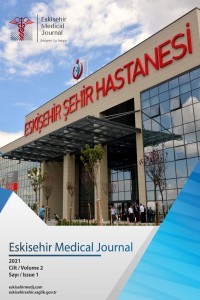COVID-19 pnömonisinde spontan pnömotoraks ve pnömomediastinum
SARS-CoV-2, pnömotoraks, pnömomediastinum, komplikasyon, mortalite
Spontaneous Pneumothorax and Pneumomediastinum in COVID-19 Pneumonia
SARS-CoV-2, Pneumothorax, Pneumomediastinum, Complications, Mortality,
___
- World Health Organization (internet). WHO announces COVID-19 outbreak a pandemic 2020. https://www.who.int/ docs/default-source/coronaviruse/situation-reports/20200531- covid-19-sitrep-132.pdf? Sfvrsn=d9c2eaef_2.
- Salehi S, Abedi A, Balakrishnan S, Gholamrezanezhad A. Coronavirus disease 2019 (COVID-19): A systematic review of imaging findings in 919 patients. AJR Am J Roentgenol .2020 Jul;215(1):87-93.
- Martinelli AW, Ingle T, Newman J, et al. COVID-19 and pneumothorax: A multicentre retrospective case series. Eur Respir J. 2020 Sep 9 ;56(5).
- Flower L, Carter JPL, Rosales Lopez J, Henry AM. Tension pneumothorax in a patient with COVID-19. BMJ Case Rep. 2020 May 17;13(5): e235861.
- Lu R, Zhao X, Li J, et al. Genomic characterisation and epidemiology of 2019 novel coronavirus: implications for virus origins and receptor binding. Lancet. 2020 Feb 22;395(10224):565–74.
- De Michele S, Sun Y, Yilmaz MM, et al. Forty Postmortem Examinations in COVID-19 Patients. Am J Clin Pathol. 2020 Nov 4 ;154(6):748–60.
- Wang W, Gao R, Zheng Y, Jiang L. COVID-19 with spontaneous pneumothorax, pneumomediastinum and subcutaneous emphysema. J Travel Med. 2020 Aug 20;27(5).
- Petrilli CM, Jones SA, Yang J, et al. Factors associated with hospital admission and critical illness among 5279 people with coronavirus disease 2019 in New York City: Prospective cohort study. BMJ. 2020 May 22;369.
- McGuinness G, Zhan C, Rosenberg N, et al. Increased incidence of barotrauma in patients with COVID-19 on invasive mechanical ventilation. Radiology. 2020 Nov 1;297(2): E252–62.
- Ai T, Yang Z, Hou H, et al. Correlation of Chest CT and RT-PCR Testing for Coronavirus Disease 2019 (COVID-19) in China: A Report of 1014 Cases. Radiology. 2020 Aug1 ;296(2): E32–40.
- Sun R, Liu H, Wang X. Mediastinal emphysema, giant bulla, and pneumothorax developed during the course of COVID-19 Pneumonia. Korean J Radiol. 2020 May 1 ;21(5):541–4.
- Huang C, Wang Y, Li X, et al. Clinical features of patients infected with 2019 novel coronavirus in Wuhan, China. Lancet. 2020 Feb 15 ;395(10223):497–506.
- Hu B, Zeng LP, Yang X Lou, et al. Discovery of a rich gene pool of bat SARS-related coronaviruses provides new insights into the origin of SARS coronavirus. PLoS Pathog . 2017 Nov 30;13(11):e1006698.
- Wang D, Hu B, Hu C, et al. Clinical Characteristics of 138 Hospitalized Patients with 2019 Novel Coronavirus-Infected Pneumonia in Wuhan, China. JAMA - J Am Med Assoc. 2020 Mar 17;323(11):1061–9.
- Chen N, Zhou M, Dong X, et al. Epidemiological and clinical characteristics of 99 cases of 2019 novel coronavirus pneumonia in Wuhan, China: a descriptive study. Lancet. 2020 Feb 15 ;395(10223):507–13.
- Sihoe ADL, Wong RHL, Lee ATH, et al. Severe acute respiratory syndrome complicated by spontaneous pneumothorax. Chest. 2004;125(6):2345–51.
- Ioannidis G, Lazaridis G, Baka S, et al. Barotrauma and pneumothorax. J Thorac Dis. 2015;7(Suppl 1):S38-43.
- Sheard S, Rao P, Devaraj A. Imaging of acute respiratory distress syndrome. Respir Care . 2012 Apr;57(4):607-12.
- Ucpinar BA, Sahin C, Yanc U. Spontaneous pneumothorax and subcutaneous emphysema in COVID-19 patient: Case report. J Infect Public Health.2020 ;13(6):887–9.
- Lin X, Gong Z, Xiao Z, Xiong J, Fan B, Liu J. Novel coronavirus pneumonia outbreak in 2019: Computed tomographic findings in two cases. Korean J Radiol. 2020 ;21(3):365–8.
- Zantah M, Dominguez Castillo E, Townsend R, Dikengil F, Criner GJ. Pneumothorax in COVID-19 disease- incidence and clinical characteristics. Respir Res. 2020 Sep 16;21(1):236.
- Park SJ, Park JY, Jung J, Park SY. Clinical manifestations of spontaneous pneumomediastinum. Korean J Thorac Cardiovasc Surg. 2016;49(4):287–91.
- Wang W, Gao R, Zheng Y, Jiang L. COVID-19 with spontaneous pneumothorax, pneumomediastinum and subcutaneous emphysema. J Travel Med . 2020 Aug 20;27(5):taaa062.
- Imam Z, Odish F, Gill I, et al. Older age and comorbidity are independent mortality predictors in a large cohort of 1305 COVID-19 patients in Michigan, United States. J Intern Med. 2020 Oct 1;288(4):469–76.
- Filice GA. SARS, pneumothorax, and our response to epidemics. Chest . 2004 Jun;125(6):1982-4.
- ISSN: 2718-0948
- Yayın Aralığı: Yılda 3 Sayı
- Başlangıç: 2020
- Yayıncı: Eskişehir Şehir Hastanesi
Fragmente QRS'nin Varlığı Hemodiyaliz Hastalarında Ventriküler Aritmi ile İlişkili Olabilir
Fatih KARDAŞ, Gökay TAYLAN, Çağlar KAYA, İlhan KURULTAK
COVID-19 Pandemisi Sırasında Acil Genel Cerrahi İhtiyacı Olan Hastaların Retrospektif Analizi
Gürkan ALTUNTAŞ, Murat Mümin YAZICI, Özlem BİLİR, Gökhan DEMİRAL, Gülcan Nur YILMAZ
Nadir Olarak Görülen Alüminyum Fosfit Solunmasına Bağlı Zehirlenme Vakası
Demet YALÇIN, Bayram Furkan CANDAN, Mehmet MUTLU, Birgül YELKEN
Çoklu Akciğer Metastazları İçin Stereotaktik Radyoterapi: Erken Klinik Sonuçlar
Ayhan KÜP, Mehmet ÇELİK, Şeyhmus KÜLAHÇIOĞLU, Abdulkadi USLU, Mert EVLICE, Mehmet Muhsin TÜRKMEN, Ramazan KARGIN
Mine TEPETAŞ, Alaettin ÜNSAL, Ahmet AY, Sevda SUNGUR, Didem ARSLANTAŞ, Halime KÜÇÜK
Koroner no-reflow fenomeninde kontrast ilişkili akut böbrek hasarını öngördüren faktörler
Gökay TAYLAN, Çağlar KAYA, İlhan KILIÇ, Cihan ÖZTÜRK, Kenan YALTA
İbrahim Alper YAVUZ, Onur GÖK, Utku GÜRHAN, Fuad ÖKEN
COVID-19 pnömonisinde spontan pnömotoraks ve pnömomediastinum
Atilla PEKÇOLAKLAR, Hasan Oğuz KAPICIBAŞI
Neisseria animaloris'in neden olduğu bir pnömoni olgusu
Taylan ÖNDER, Sevil ALKAN, Çisil Şeyma ÖZEL, Safiye Bilge GÜÇLÜ KAYTA, Anıl AKÇA, Cihan YÜKSEL, Servan VURUCU
